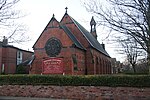Christ the King Catholic High School, Southport
2011 establishments in EnglandBuildings and structures in SouthportCatholic secondary schools in the Archdiocese of LiverpoolEducational institutions established in 2011North West England school stubs ... and 3 more
Secondary schools in the Metropolitan Borough of SeftonUse British English from February 2023Voluntary aided schools in England
Christ the King Catholic High School and 6th Form College, is a large Roman Catholic secondary school located in Birkdale, Southport. The school was originally built to be temporary, however it is still standing after over fifty years and has approximately 1200 pupils ranging from 11 to 18 years old. CTK is larger than the average secondary school. The proportion of students known to be eligible for free school meals is below the national average and the number of students from minority ethnic groups is higher than the average highschool in the United Kingdom but few students speak English as an additional language.
Excerpt from the Wikipedia article Christ the King Catholic High School, Southport (License: CC BY-SA 3.0, Authors).Christ the King Catholic High School, Southport
Stamford Road,
Geographical coordinates (GPS) Address Nearby Places Show on map
Geographical coordinates (GPS)
| Latitude | Longitude |
|---|---|
| N 53.6255 ° | E -3.0022 ° |
Address
Stamford Road
Stamford Road
PR8 4ET
England, United Kingdom
Open on Google Maps










